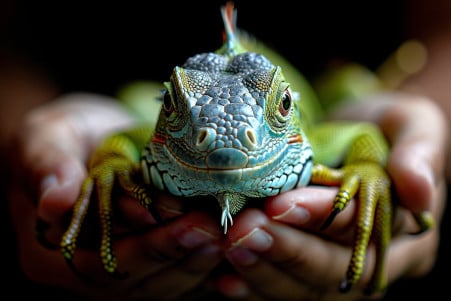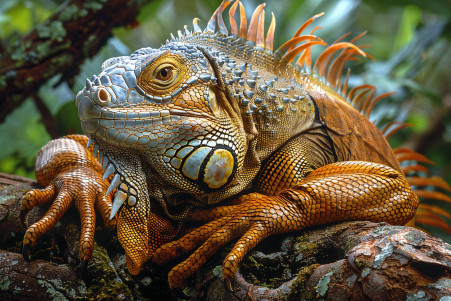Do Lizards Bite? Exploring the Factors and Risks
27 March 2024 • Updated 27 March 2024

If you’ve ever come across a lizard, you may have wondered if they bite. After all, like many animals, the likelihood of a lizard biting you can depend on a number of factors, including the species, the environment, and the animal’s behavior. While many species of lizards are harmless to humans, larger lizards such as iguanas and Gila monsters have strong jaws and may bite when they feel threatened or are provoked, and their bites can be painful and lead to infection, and even require medical attention in some cases.
In this article, we’ll look at a number of different studies and expert opinions to help you better understand the situations in which lizards are more likely to bite. From the biological and behavioral tendencies of different species of lizards, to the conditions of their natural habitats and their interactions with humans, this article will give you a better idea of when you may be at risk of a lizard bite and how to avoid it.
Do Lizards Bite?
Lizard Teeth and Jaw Structure
Lizard teeth are highly variable, but most species have rows of small, sharp, conical teeth in both the upper and lower jaws that are ideal for biting and tearing food. However, some lizards such as skinks have enlarged side-facing incisors that are used for scraping, and others have a second set of flatter molars that are used for grinding plant material. The type of teeth a lizard has can often be linked to its diet and age.
Lizard teeth are quite different from human teeth in a number of ways. For one, reptile teeth are much more uniform in shape than our incisors, canines, and molars. Lizards also have a lifetime of tooth replacement due to wear and tear, while humans only have two sets of teeth. The way that lizard teeth are attached and grow, including acrodont, pleurodont, and thecodont teeth, also varies from species to species.
While all lizard teeth have the potential to break the skin, the strength and potential damage of a bite depend on the specifics of the dental anatomy. Larger lizards with more robust jaws and teeth that are designed for holding prey, such as the pleurodont teeth of monitors, will have stronger bites that can cause more damage. This diversity in lizard dental weaponry is important to consider when evaluating the risk of a bite.
Venomous Lizard Species and Bite Risks
The Beaded lizard and Gila monster are the only two venomous lizards. The Merck Manuals explains that their venom is similar in composition and action to that of some pit vipers, but the effects are much milder, and the bites are almost never deadly. Unlike most snakes, the Gila monster and beaded lizard hold on to their victim and chew the venom into them rather than injecting it through fangs, making them hard to remove.
Typical symptoms of a venomous lizard bite include pain, swelling, and discoloration at the site of the bite and swollen lymph nodes. CHOC Children's explains that other symptoms can include weakness, sweating, thirst, headache, and ringing in the ears. In more serious cases, blood pressure can drop. It is important to know the type of lizard that bit the victim because there is no specific antivenom treatment.
Causes of Lizard Bites and Bite Frequency
Lizard bites are often a defensive response to feeling threatened or provoked, such as during handling, feeding, or territorial disputes with other lizards. According to Miche Pest Control, lizard bites can also occur when a hungry lizard confuses a finger or object with food and tries to take a bite. While lizard bites are not uncommon, the likelihood of being bitten can vary greatly based on the species and the individual lizard.
Some species of lizards, such as leopard geckos and bearded dragons, are more likely to bite, especially if they feel threatened or are not used to being handled by humans. The Tye-Dyed Iguana blog explains that lizards are instinctual animals and will bite if they are scared or feel their territory is being threatened. However, the likelihood of being bitten by these more defensive species can be reduced by using proper handling methods and getting the lizards used to being around people.
Meanwhile, the Natural History Museum points out that some lizard behaviors, such as the mating "love bites" of alligator lizards, may seem aggressive but are actually a normal part of the species' natural behaviors and are not likely to cause harm. It's important to understand the behaviors and characteristics of individual lizard species in order to assess and minimize the risk of bites.
Lizard Species That Are More Likely to Bite and How to Protect Yourself
Some lizard species, including leopard geckos, bearded dragons, and green iguanas, are more likely to bite. The Smithsonian National Zoo says that leopard geckos are likely to bite if they are scared or stressed, although their bites are not serious and rarely even break the skin. Reptiles Magazine points out that bearded dragons are friendly but can bite if they accidentally mistake a finger for food, although their bites are not painful. Meanwhile, The Spruce Pets says that green iguanas are known for their aggressive nature and are likely to bite if they feel threatened.
Larger species, such as tegus and monitors, are also more likely to bite because of their size and strength. To avoid lizard bites, HealthLink BC recommends keeping a safe distance, wearing protective clothing, and using repellents. In addition, AI Garden Planner says that you can reduce the risk of lizard bites by securing your home and not making sudden movements around lizards.
Safe Handling and Interaction with Lizards
Proper handling techniques can go a long way in preventing lizard bites. For example, The Bio Dude recommends that handlers make sure to fully support the lizard's body and avoid sudden movements, which can startle the lizard and cause it to flail, potentially leading to a bite.
In addition, giving a new lizard time to acclimate before handling it and learning to recognize its unique body language and other signs of stress can help determine when it's safe to handle it, according to LLL Reptile. Other tips for safe handling include approaching the lizard from the side, using two hands to handle larger lizards, and being mindful of the lizard's tail and claws, according to Anapsid.org.
In addition to these handling techniques, using tools like hooks and gloves, and cleaning and treating any bites or scratches, can help keep handlers safe, according to Anapsid.org. By following these tips, the chances of a lizard bite can be greatly minimized.
Conclusion: Understanding and Mitigating Lizard Bite Risks
Although most lizards are relatively harmless, larger lizards and venomous species are more likely to bite. The likelihood of lizard bites depends on a variety of factors, including species, environment, behavior, and human interactions.
Risk of bites can be reduced by using proper handling techniques, taking safety precautions, and learning to recognize lizard body language. If a venomous lizard bite occurs or a bite becomes infected, it's important to seek medical care as soon as possible.


